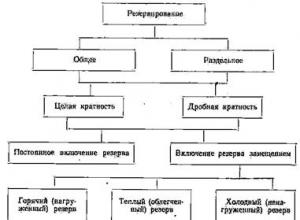How to make a full backup of Android. File extension BACKUP How to open backup
Contacts, photos, progress in games - smartphones contain no less necessary information in their memory than computer hard drives. Android backup prevents the loss of important data by storing it securely on Google servers or on your computer.
Backup to Google servers
For Android to work fully, you need a Google account - a Gmail account, with which you can log in to any service from the global corporation. Therefore, an Android backup to Google is the easiest way to save your content and settings. To back up your contacts, some application data, calendar and disk, just add your Google account in the settings and turn on synchronization.

The marked data will be automatically saved to Google servers. To restore them to your phone from a backup or transfer them to another device, just add an account and enable synchronization. 
There is also a “Backup and Reset” section in your phone settings. Here you need to enable backup, add a Google account for synchronization and activate auto-recovery, which will help you return a copy of the settings and data of some applications when you reinstall them. 
Important information is stored on Google servers, but, for example, progress in a game cannot be transferred to another device using such synchronization. If you want to save absolutely all your data, then you need to know how to make a full backup.
Backup via Recovery
The standard Android recovery menu has extremely limited functionality - resetting settings and installing updates. But if you install an alternative Recovery (for example, Clockworkmod) on your phone, you can perform a number of operations, including backup. In fact, this will not be a backup copy of the data, but a full-fledged snapshot of the system. 
If you don’t know what custom Recovery is and have never installed it, then it is recommended to immediately move on to the next point in the guide, which describes how to create a backup using a program for backing up Android on a PC, called Adb Run.
If you have a custom Recovery, then making a snapshot of Android is not difficult:
- Turn off the phone, go to Recovery (usually you need to hold down the “Volume +” and “Power” keys).
- Use the volume rocker and power button to open the “Backup and Restore” section.
- Select "Backup" to create a copy of the current firmware state.

The backup will be saved to the memory card, in a folder called “CWM” or “TWRP”, depending on what Recovery is installed. Then there are two options:
- Store the system image on a memory card.
- Connect your phone to your computer and transfer the backup to your hard drive so as not to fill the mobile device’s memory with a large amount of data.
To restore Android data after a backup via Recovery, you need to make sure that the system image is in the appropriate folder on the SD card. Then you should go to Recovery again, open the “Backup and Restore” section and go to “Restore”. A list of backups available for restoration will appear, from which you need to select the appropriate system snapshot.
Using the Adb Run program
If you want to backup Android to a computer without creating a backup in the Recovery menu and setting up a Google account, then use the free ADB RUN utility. For it to work, two conditions must be met:
- USB debugging is enabled on your phone.
- Mobile device drivers are installed on your computer.
The drivers must be for the model that you connect to the computer. If the conditions are met, you can proceed to creating a backup copy.

The backup copy is stored on the computer, to return the data to the phone, you need to run Adb Run again and go to the “Backup” section. Here you should open the “Adb Restore” subsection and select the desired backup, after which the data will be copied back to the mobile device’s memory and to the SD card. 
Methods for creating a backup copy on Android are not limited to the tools described. In the Play Market you can find a dozen applications (with root or without root) that allow you to save different amounts of data - Safe Backup, Super Backup, Titanium Backup. But before using the application's capabilities, be sure to read user reviews about its operation - some programs are unstable.
Do you have a backup copy of userdata_*.backup created in stock Recovery Android and need to extract data from it? Here's how to do it:
The Android +1 website (this one, not its clones) is remarkable in that it contains unique information that is presented in an accessible manner. This time we have prepared another useful material.
Now in this article we will tell you how to open a backup using 2 methods.
Method 1. Open the backup copy userdata_*.backup
If userdata_*.backup when trying to open it via 7-zip was unsuccessful, move on to the second method.
Method 2. Open the backup copy userdata_*.backup
First of all, you will need to install Ubuntu Linux on your computer or create a virtual machine with Ubuntu Linux (we will tell you later).



Extracting data, where is what?
All video files, photos, video, audio, documents can be found in the /media/o/ folder.  The contacts database can be found in the path data/com.android.providers.contacts/databases/ file contacts2.db (
The contacts database can be found in the path data/com.android.providers.contacts/databases/ file contacts2.db (
Copying open files often poses a problem when backing up data in Windows. Despite the fact that, for example, your backup software supports all the necessary data types, problems may arise with copying used system files or files occupied by applications.
The situation becomes especially delicate when there are quite a lot of such files or one edited file is of fundamental importance for the entire backup (as, for example, in the case of a transaction log in the case of archiving a 1C database). And the problem is that if you do not “freeze” writing to these files, then the entire backup copy will be useless during recovery.
However, it is quite obvious that close open files systems or, for example, databases impossible(to do this you will have to stop its operation). Because even the shortest period of downtime can be costly. The same applies to a backup of the system or system disk, because for this we will have to make a backup from another system.
How to create backup copies of open files
Fortunately, for now there are funds to combat this problem. The Volume Snapshot Service allows you to take snapshots of your hard drive or part of it without interrupting the system or closing open application files.
The idea is that this service helps temporarily move editing of the most recently opened files to another location on the disk, thus allowing your backup program to work with the version of this file that was at the time the backup was started. Moreover, after its completion, the edited part returns to its rightful place. This is exactly how it works copy open file. It is very important that the backup software is able to support this technology.
Copying open files using Handy Backup
Our program allows you to simply and fully work with open files and includes such powerful functionality as creating an image of a hard drive (including the system one) and restoring the system from the image. It can also fully work with MS SQL (including x64 versions) and some other ODBC-compatible databases.
Modern smartphones store a huge amount of necessary and important information, and each user customizes the phone individually. And so, when switching to a new device, the Android owner is faced with a situation where the operating system needs to be configured again. The ideal solution here is a deep or partial backup. But not everyone knows how to make a full Android backup quickly and safely using a tablet or phone without losing important data.
How to backup individual applications on Android
It is not always necessary to copy the entire system, and the process is quite painstaking. If you need to save only specific programs, we recommend using this method. And here the ideal option is the Helium application.
This tool can be freely downloaded from . It works on two “bases”: either provision and all frauds are carried out only on a smartphone, or access to a PC if you do not have “Superuser” mode.
The application allows you to save copies to and in cloud storages, namely Drobox, Google Drive and Box, which is very convenient.
She can:
- Back up the history of incoming and outgoing calls;
- Backup of applications and their settings;
- Backup SMS and contacts.
The paid premium version has more advanced functionality, but if you only need to save, for example, games, the free version will be enough.
The application works perfectly on the latest versions of the operating system, mainly Android 7.0, 7.1 and 8.0. Now let’s look at what actions we will perform in it:
- Download and install the application on your phone. If there is no root rights, repeat this procedure on the computer. Versions are available for both Windows and Mac. Drivers are also required for the PC. You can find them on the official website of the manufacturer of the connected smartphone.
- Now let's proceed directly to the backup operation itself. To do this, open the application on the device. If necessary, we connect via a wire to the computer. We are offered several options: a full backup of the phone or only specific applications. Please note that you can copy the entire program with data, or just the data.
- After all the checkboxes are checked, click "Backup". Choose where to save. If to the Cloud, then indicate the address; if to a computer, open the service with the IP address and transfer it to the search bar of the browser. There we allow copying. Ready. The copies were created successfully.
 But here things are a little more complicated, since we need a complete saved copy of Android. Of course, it will take up more space, and there are several different ways to create it.
But here things are a little more complicated, since we need a complete saved copy of Android. Of course, it will take up more space, and there are several different ways to create it.
Backup via system option (No Root)

The easiest and most comfortable option, suitable for beginners and simply users who did not want to waste their time. Opening "Settings", go to point "System" – "Backup", in the location we select Google Drive. Made. The following information will be saved:
- Standard settings (language, time and date);
- Wi-Fi hotspots and passwords, if activated;
- Screen settings (wallpaper, themes, brightness);
- Applications (in most cases just a list, but not internal settings and achievements in games);
- Content located in Google Calendar;
- Materials stored in Gmail, individual mail settings.
Root rights are not required; their presence does not affect the quality of the backup in any way.
Unfortunately, failures during the backup process are possible, which is why many users complain about the insufficient amount of stored information. And on some devices, such a system function refuses to work at all; this may affect phones with an operating system lower than Android 6.0.
Backup Android using FlashTool (No Root)

This is a more serious and difficult procedure that allows you to back up the entire firmware. There will be many stages, and For users who are not confident in their abilities and technical knowledge, we do not recommend this option! But if you are an experienced Android expert, then you can safely get started.
To begin with, we prepare all the necessary materials so that during the backup process we do not have to be distracted by them.
- Download the program itself directly from the official website of the developer ( flashtool.net);
- We find original firmware, made specifically for your smartphone;
- If there are no MTK drivers on your computer, download them.
- We gain access to the PC, since without it backup is impossible here, we check the functionality of the USB cable and the serviceability of the connectors.
- Next, extract two files from the firmware, namely the name of the number with permission txt And weg_l.bin. We move these materials to a separate, empty folder.
- We also place the folder where the software is stored there.
- Launch the previously downloaded FlashTool program on behalf of the administrator, this is a prerequisite.
- A page opens where you need specify the path to scatter.txt using a built-in conventional conductor.
- A new screen should appear where the memory blocks are located. It is necessary to make a backup with them. For this go to the “Memory Test” tab. We check the boxes next to the first five points.
- Turn off the phone, click on the computer "Start".
- Now we connect the smartphone using USB.
- The information begins to be read and displayed on the screen. Once the process is completed, disconnect the device from the personal computer.
- Opening "Notebook" and transfer the received data there. Please note that empty sectors do not need to be copied. Save and close the notepad.
- We return to the FlashTool main page again, uncheck the checkbox next to the first item.
- Open the section “Readback” – “Add”. A new line appears, which we double-click on.
- We indicate where exactly to save the backup and come up with a name.
- A small menu appears asking you to specify settings for each sector. Yes, yes, a separate memory block needs separate configuration. We change only the “Length” column, to which we add block data from a saved notebook.
- Click "OK" and press the top button "Read Back"
- And the last final step: reconnect the phone and watch the copying process. At the end, a green icon should appear indicating that the operation is complete. Made! Now we repeat similar actions with the remaining sectors.
After the backup is complete, the files can be moved to any cloud storage, because if some major trouble happens to your computer or hard drive, the saved information will be lost, don’t risk it!
So we made a backup on Android via FlashTool using a computer, now we are trying the following method.
Backup via Titanium Backup (Root)

Quite light and comfortable option using special Titanium Backup program. You can download it without any problems from Google Play and install it in the standard way.
Now we launch the application and give it access to root rights. Yes, “Superuser” mode is required here, and this, in principle, is the main disadvantage of this utility. Click on the checkmark image in the upper right corner to go to the page "Batch Actions" and choose what data we want to save. Click next to what you want "Start".

Another decent option that works on all devices, but from experience I will say that it is much easier than the FlashTool method. For this we need recovery mode. Of course, the most popular and most functional is TWRP, allowing you to install custom firmware, different kernels, but for backup is quite suitable and stock. Begin:
- Make sure your smartphone has more than 60% charge.
- Turn off the phone, after about 30 seconds press the power button and the volume rocker down or up, differently on different models.
- Next, an image of an Android robot with an exclamation mark may appear. If this happened - press the same key combination, but do not hold it. Did you immediately go to recovery? Then we skip this point.
- Now we find ourselves in the recovery menu itself, only here touch input no longer works. We will switch with keys: the volume rocker, accordingly, is a command "up", volume down rocker – "down", on/off button – "OK".
- We go down to the point "backup/restore» , click "backup". The copying procedure begins, which takes on average up to 10 minutes. During this period of time, we don’t press anything, we don’t turn on the smartphone, we just wait.
- When the operation ends, we reboot the smartphone. That's all, ready, the backup of the Android firmware is done.

IMEI, as we know, is the unique identification number of a smartphone. And quite often there are situations when this number needs to be saved, that is, backed up. For this we will use special program Root Explorer. Root rights are also required for it to work.
We open the application, through it we go to the root of the device, where the one we need is located efs folder We carry out a long press, after which an additional mini-menu appears, where we select "Create archive"(Archive permission is at your discretion).
Backing up instant messengers
Messengers for the modern user are simply a necessary thing, helping both to communicate with friends and, for example, to send a photo of completed work to the boss. Let's look at the example of WhatsApp. It stores a huge amount of necessary information: important messages, images, phone numbers. And the ideal way not to lose such materials is to make a backup. How to do it on WhatsApp?
Built-in backup option
All popular instant messengers have their own backup function, which allows you to save the necessary materials directly from the application itself. WhatsApp is no exception.
Begin:
- Find the application, open the menu;
- Click "Settings", now go to the tab "Chats" and click "Backup copy".
- Choose saving to Google Drive and setting the frequency of saving.
- If you have several Google accounts, select the desired one in the window that appears. Haven't registered or logged in to your account yet? Then click "Add account".
- And in the last column we select the network under which the copying will take place. Don't forget that using mobile Internet may result in additional charges for the megabytes used.
The scheme of working with this application is very simple: after installation, go into it, click "Applications", put a tick opposite “WhatsApp” – “Save”. The backup made, or rather the path to save it, can be found in the section "Archived".
Backup using Restore Transfer
Another decent app created by the developer Trustlool Apps. Fully translated into Russian, the interface is simple and clear. Besides, There is a huge plus for beginners and inexperienced users - root rights are not needed.
How can I restore a copy made in Restore?
To do this, go to the application, open the section there "Archive", find the necessary materials, and after checking the box, click "Restore".
Is Super Backup free? I heard that you have to pay for it.
There are two versions of this tool: basic, that is, having small but useful functionality, and extended premium. In the first option, no payment is required, but for the second you will have to pay. Both versions are freely available on Google Play.
As you can see, on Android it’s quite easy to make a backup; you can save firmware, instant messengers, applications, and always have the necessary information at hand. The most important thing is to be attentive and strictly follow the instructions. Good luck!
The most common cause of problems with opening the BACKUP file is simply the lack of appropriate applications installed on your computer. In this case, it is enough to find, download and install an application that serves files in the BACKUP format - such programs are available below.
Search system
Enter file extension
Help
Clue
Please note that some encoded data from files that our computer does not read can sometimes be viewed in Notepad. In this way we will read fragments of text or numbers - It is worth checking whether this method also works in the case of BACKUP files.
What to do if the application from the list has already been installed?
Often an installed application should automatically link to a BACKUP file. If this does not happen, then the BACKUP file can be successfully associated manually with the newly installed application. Simply right-click on the BACKUP file, and then from the available ones select the "Choose default program" option. Then you need to select the “View” option and find your favorite application. The entered changes must be approved using the "OK" option.
Programs that open the BACKUP file
Windows
Why can't I open a BACKUP file?
Problems with BACKUP files may also have other causes. Sometimes even installing software on your computer that supports BACKUP files will not solve the problem. The reason for the inability to open and work with the BACKUP file may also be:
Inappropriate BACKUP file associations in registry entries
- corruption of the BACKUP file that we open
- infection of the BACKUP file (viruses)
- too little computer resource
- outdated drivers
- removing the BACKUP extension from the Windows registry
- incomplete installation of a program that supports the BACKUP extension
Fixing these issues should result in you being able to open and work with BACKUP files freely. In case your computer still has problems with files, you need to take the help of an expert who will determine the exact cause.
My computer does not show file extensions, what should I do?
In standard Windows system settings, the computer user does not see the BACKUP file extension. This can be successfully changed in the settings. Just go to the "Control Panel" and select "View and Personalization". Then you need to go to "Folder Options" and open "View". In the "View" tab there is an option "Hide extensions of known file types" - you must select this option and confirm the operation by clicking the "OK" button. At this point, the extensions of all files, including BACKUP, should appear sorted by file name.
Latest site materials
Programs

Background color How to make the background colored in html
When setting up any website, in addition to functionality, design is very important. This is what sets the own style and design of a particular company or person for whom the website is being created. Customizing the background color and image is easy by following the instructions
Browsers

How can I find out what song is playing now and who sings it?
To find it and add it to your collection? If there are words or a fragment of a song. If you understand at least a few words from the song or, even better, remember a piece of the text, enter the words in any search engine. Having found the title of a song, it’s not easy to find out the artist.
Video

How to enable and disable Push Notifications?
Apple is responsible for the correct operation of Push notifications in iOS. Any third-party application that wants to send notifications to the user must use Apple servers for this. The scheme looks like this: the developer will raise his own ser
Video

Download themes for Android phone The best themes for your phone
I wanted to post wallpapers for a mobile phone - I don’t think it’s worth talking about the fact that they will look great only at the resolution indicated in the title, in other cases they will be stretched out or, conversely, not on the entire screen. Pictures
Social media

Yandex browser constantly starts: how to cancel the launch, make the browser launch without an additional window
Yandex is a popular browser that pleases its fans with a high level of functionality. A careful study of the program allows us to note the stability and reliability of its operation, user-friendly interface, and prompt loading of any pages. Despite this, in
